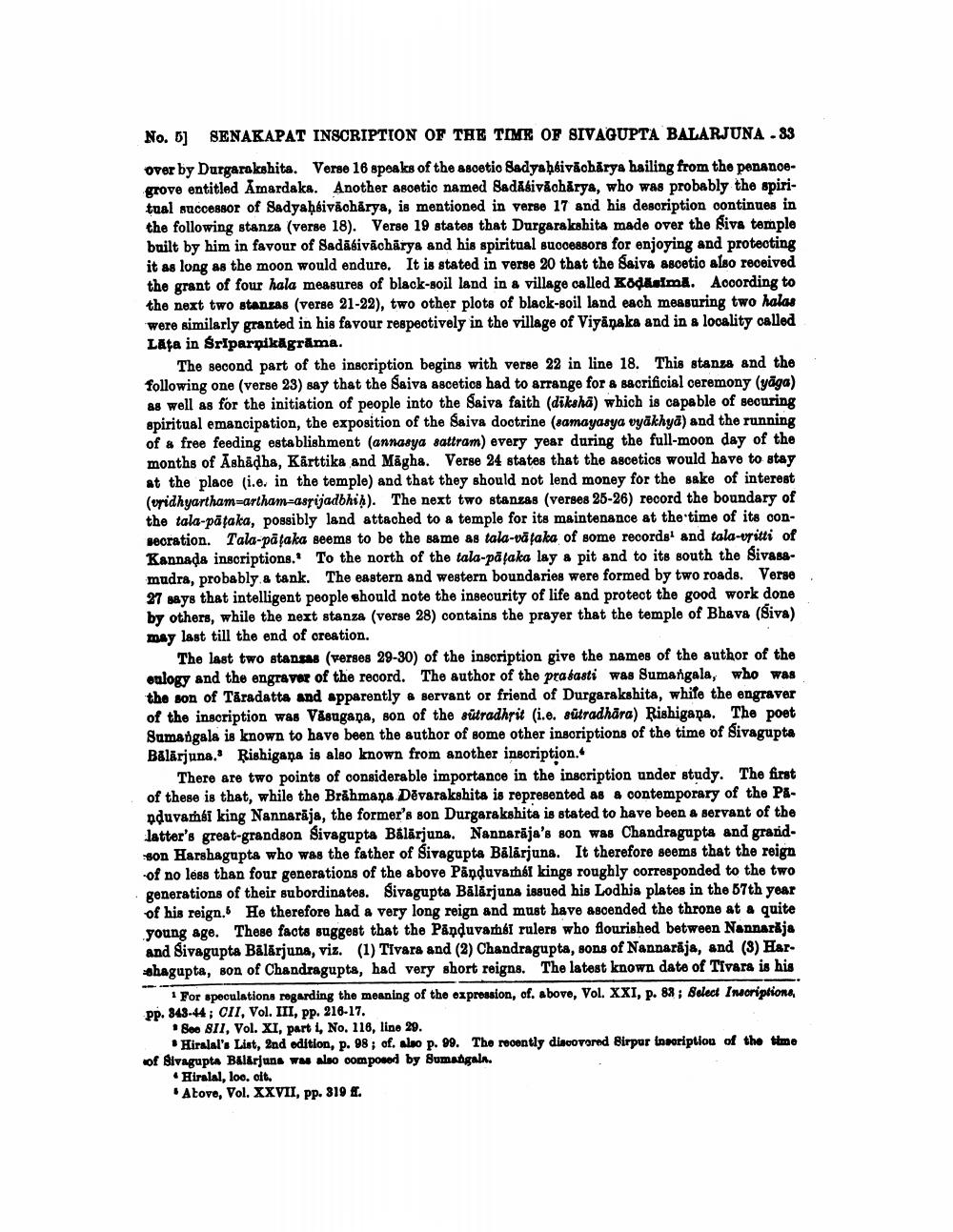________________
No. 6] SENAKAPAT INSCRIPTION OF THE TIME OF SIVAGUPTA BALARJUNA .83 over by Durgarakshita. Verse 16 speaks of the ascetic Sadyahbivācbärya hailing from the penancegrove entitled #mardake. Another ascetic named Sadasivacharya, who was probably the spiritual successor of Sadyaḥdivācharya, is mentioned in verse 17 and his description continues in the following stanza (verse 18). Verse 19 states that Durgarakshita made over the Šiva temple built by him in favour of Sadāsivacharya and his spiritual successors for enjoying and protecting it as long as the moon would endure. It is stated in verse 20 that the Saiva ascetio also received the grant of four hala measures of black-soil land in a village oalled Kodlama. According to the next two stanzas (verse 21-22), two other plots of black-soil land each measuring two halos were similarly granted in his favour respectively in the village of Viyanaka and in a locality called Lata in Sriparpikāgrāma.
The second part of the inscription begins with verse 22 in line 18. This stanza and the following one (verse 23) say that the Saiva ascetics had to arrange for & sacrificial ceremony (yāga) as well as for the initiation of people into the Saiva faith (diksha) which is capable of securing spiritual emancipation, the exposition of the Saiva doctrine (samayasya vyakhya) and the running of a free feeding establishment (annasya satiram) every year during the full-moon day of the months of Ashādha, Kärttika and Mägha. Verse 24 states that the ascetics would have to stay at the place (i.e. in the temple) and that they should not lend money for the sake of interest (vridhyartham=artham-asrijad hih). The next two stanzas (verses 25-26) record the boundary of the tala-pätaka, possibly land attached to a temple for its maintenance at the time of its consecration. Tala-pāțaka seems to be the same as tala-vä taka of some records and tala-upitti of Kannada inscriptions. To the north of the tala-pājaka lay a pit and to its south the Sivassmudra, probably a tank. The eastern and western boundaries were formed by two roads. Verse 27 says that intelligent people should note the insecurity of life and protect the good work done by others, while the next stanza (verse 28) contains the prayer that the temple of Bhava (Siva) may last till the end of creation.
The last two stansas (verses 29-30) of the inscription give the names of the author of the onlogy and the engraver of the record. The author of the prasasti was Sumangala, who was the son of Tăradatta and apparently & servant or friend of Durgarakshita, white the engraver of the inscription was Visugana, son of the sutradhrit (i.e. sutradhāra) Rishigana. The poet Sumangala is known to have been the author of some other inscriptions of the time of Sivagupta Balärjuna. Rishigana is also known from another insoription..
There are two points of considerable importance in the inscription under study. The first of these is that, while the Brahmana Dēvarakshita is represented as a contemporary of the PAnduvamsi king Nannarāja, the former's son Durgarakshita is stated to have been & servant of the latter's great-grandson Sivagupta Bálärjuna. Nannarāja's son was Chandragupta and grandson Harshagupta who was the father of Sivagupta Bālārjuna. It therefore seems that the reign of no less than four generations of the above Panduvarhól kings roughly corresponded to the two generations of their subordinates. Sivagupta Bālārjuna issued his Lodhja plates in the 67th year of his reign. He therefore had a very long reign and must have ascended the throne at a quite young age. These facts suggest that the Pāņduvansi rulers who flourished between Nannarāja and Sivagupta Bālārjuna, viz. (1) Tivara and (2) Chandragupta, sons of Nannarāja, and (3) Har. shagupta, son of Chandragupta, had very short reigns. The latest known date of Tivara is his
For speculations rogarding the meaning of the expression, of, above, Vol. XXI, p. 88; Select Inscriptions pp. 848-44; CII, Vol. III, pp. 216-17.
Seo 811, Vol. XI, part 1, No. 116, line 29.
Hiralal's List, 2nd edition, p. 98; of. slao p. 99. The rooently discovered Sirpur inseription of the time of Bivagupta Belarjuna was also composed by Bumangain.
• Hiralal, loc. cit. Atovo, Vol. XXVII, pp. 319 f.




